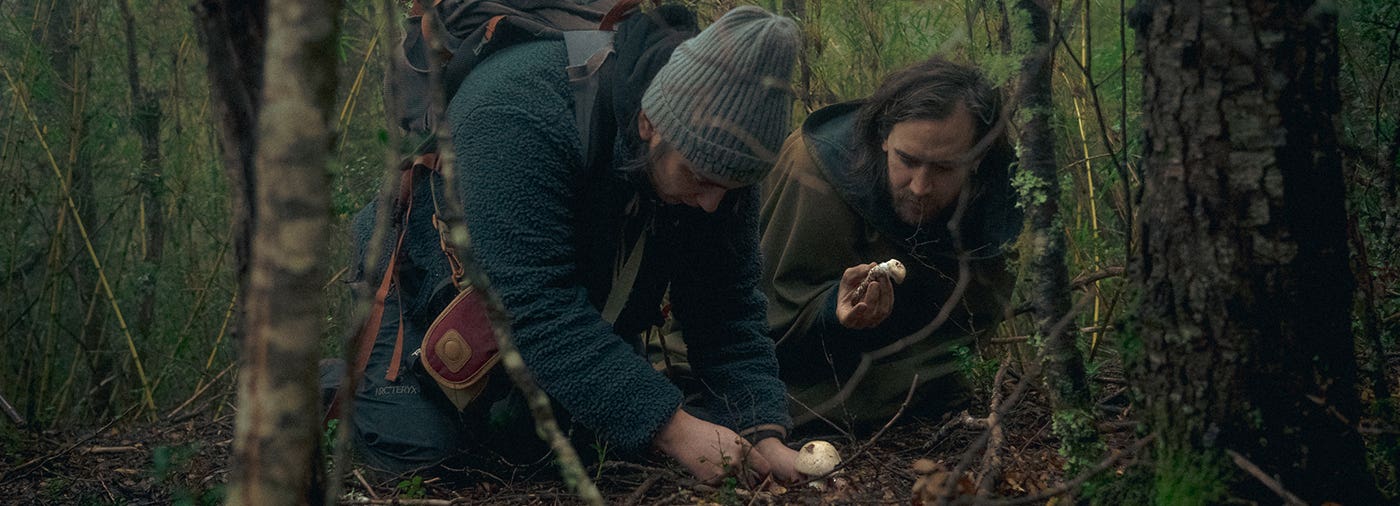A team of mycologists from the Fungi Foundation traveled to Chile’s Nahuelbuta mountain range in May 2023 searching for the Big Puma Fungus (Austroomphaliaster nahuelbutensis)--a fungi that has only been documented by science once in 1988. They were following in the footsteps of mycologist Norberto Garrido, who made two trips to the mountains in the early 1980s and collected more than 200 species of fungi. The Big Puma Fungus was one of those species, but mycologists have been left wondering if it can still be found in the mountains and why it seemingly disappeared?
“There are no photographs of the species,” says Daniela Torres, mycologist and lead member of the expedition team. “We don’t have any proof of it being found ever again; no analysis of this mycorrhizal fungi and how it interacts with its surrounding ecosystem.” The species is endemic to the temperate forest, with which it shares its name. Not much is known about the Big Puma Fungus, other than it is currently considered a monotypic genus, which means that it might be the only one of its kind out there.
The Big Puma Fungus is the first fungi species to be added to the top 25 most wanted list by Re:wild’s Search for Lost Species. The Fungi Foundation’s expedition to Nahuelbuta National Park and surrounding small towns was the first attempt to search for a “lost” fungus in Chile–and the search started before the expedition team ever stepped foot in the park.
“This time of year and this date were crucial for the expedition,” explains Torres.
It’s possible that the Big Puma Fungus only produces mushrooms on the same dates every year, which made the timing of the expedition more crucial than other environmental factors. The expedition team, which also included mycologist Claudia Bustamante and forestry engineer Gabriel Orrego, based their hypothesis on experiences with other fungi in Chile. They believed that the Big Puma Fungus would be found in the exact same locations where Norberto Garrido had encountered it in 1982.
However, identifying those exact locations was not an easy task. There is only one account of Garrido's exploration of fungi in the Nahuelbuta Mountains. Acting like detectives, the team turned to the most significant clues they had: Garrido’s thesis. It was written in German, so in order to retrace his steps, they first translated all of the mycologist’s notes and descriptions. They compiled a comprehensive profile of the Big Puma Fungus, including its macro and micro details such as its size, color, shape of the cap, lamellae (gills), stipe (stem), and spores. Thanks to Garrido’s description, the team also discovered that the fungus is associated with Patagonian Oak trees (Nothofagus obliqua) and Dombey’s Beech trees (Nothofagus dombeyi).
Based on this data and a drawing made by Garrido 35 years ago, the team created a list of other fungi he had encountered, as well as a list of those that could resemble the Big Puma Fungus.
After collecting as much information as they could, the team decided that autumn in Chile between May 15 and May 21 would be the best time to launch the search. They visited Vegas Blancas, a rural sector with little remaining native forest due to pressure from the logging industry in the region, and Piedra del Águila (Eagle's Rock) inside Nahuelbuta National Park. Garrido visited both areas on his expedition, but the team also explored a few areas outside the park that still have similar forest.
“The habitat between Vegas Blancas and the park is now largely an urban area,” says Torres. “But we did find some other species there that Garrido described on the list; they were species typical of more disturbed areas, fields, and roadside edges, such as those in the Agaricus and Lepiotas genus.”
The temperate rainforest in Nahuelbuta National Park is a hotspot for wildlife. It is filled with Monkey Puzzle Trees, an ancient conifer species, and it has more mammal species than forests in the Andes Mountains at the same latitude. The plant composition in the park is still much the same as it was when Garrido visited 41 years ago–filled with Evergreen Southern Beech trees and shrubs.
When the expedition team, along with Fundacion Nahuelbuta, an NGO focused on the defense, protection, education, and environmental restoration of the Nahuelbuta mountain range, started searching for the Big Puma Fungus in Nahuelbuta National Park, they worried that unusually dry conditions might thwart their carefully laid plans.
“I was so nervous that first morning, because I felt it was too dry,” says Gabriel Orrego. “You would scratch the leaf litter and it was dry below. We spent all morning in the forest and we couldn’t find anything.”
Suddenly, in the afternoon, a tiny mushroom caught the team’s attention. It was the same color as the Big Puma Fungus–grayish. It was in the right location and it was the right time of year.
The team compared it to the strict checklist they had developed that potential candidates of the Big Puma Fungus had to meet. Macroscopically, it appeared to be a match, and the team collected it to bring it back to the lab. Although there was still some uncertainty about the size, it was a promising candidate for the Big Puma Fungus. The team conducted an initial microscopic examination in a temporary lab set up in a cabin in the national park, but they determined that an additional and more detailed analysis of the samples would be required to confirm which species it was.
"That first mushroom was very much what we were looking for in terms of its color palette, but not such a good fit when it came to microscopic characteristics,” says Torres. “We didn’t find any other similar samples in other sections of the national park.”
But as the days marched on, it became clear just how special that ambiguous mushroom was. “We saw other species,” says Orrego. “But the fact that we were seeing all these other species in the beautiful forests, old-growth forests, but we couldn’t find another mushroom that could be a good Big Puma Fungus candidate, with the same characteristics, the same morphotype that we found the first day, made that first finding even more unique.”
“Magical.” That is how a group of local residents described a day they spent with the team of mycologists in the Nahuelbuta Mountains.
After spending nearly a week exploring Nahuelbuta National Park and its surroundings, the team felt optimistic that they had potentially discovered the Big Puma Fungus, but they suspected that they would need to organize another expedition in order to find a larger specimen and collect mushrooms in various stages of development to be sure they had found the right species.
During expeditions, the Fungi Foundation makes it a priority to educate and empower the local communities in the areas they explore to find fungi. With their fieldwork finished, they had organized an educational hike with about 25 local community members to learn about mushrooms in the forest. The team taught children and adults, ranging from five to nearly 70 years old, about the funga in the region; how to identify mushrooms that are edible; how to harvest them in a sustainable way and the different methods of collecting fungi for scientific analysis. Mycologists estimate that only eight percent of 2.2 to 3.8 million species of fungi on the planet have been described, so it’s very possible that someone out for a hike in a biodiverse area like the Nahuelbuta Mountains could discover a new fungi species.
As Orrego was explaining how to see and identify macroscopic characteristics of mushrooms, he was interrupted by two people who had been looking at a different mushroom. They were only a few yards away from the team.
“We were breathless,” says Orrego.
The two men were pointing to a group of about four mushrooms. They were gray with red tones and the stems of the mushrooms were thicker at the base. The pileus (cap) on each mushroom had a small depression in the middle and white gills underneath. It was exactly what they had been looking for all week.
At first the team froze, but then “we screamed,” says Bustamante of the moment they saw the mushrooms.
In a moment of celebration, the team embraced each other and then eagerly began collecting the mushrooms. The locals formed a circle around them as they worked, careful not to tread on any of the specimens. The team took pictures and recorded the macroscopic features of the mushrooms with the local community looking on. Back in the lab, they examined the mushrooms’ spores during an initial microscopic analysis.
“The mushrooms had everything on the strict checklist that physically matched Garrido’s description and it had larger and developed sporocarps.” says mycologist Claudia Bustamante, member of the expedition team. “However, it cannot be definitively confirmed whether it is the Big Puma Fungus or not until all the microscopic structures have been measured and compared.”
After an in-depth microscopic analysis on the mushrooms is completed, researchers will also extract DNA from them. It will be compared to the DNA of the Big Puma Fungus specimen that Garrido described 35 years ago. If the results are a match, it will conclusively prove that the expedition team rediscovered the lost Big Puma Fungus. However, that process could take months and will require delicate and sophisticated handling of Garrido’s specimen.
The possible Big Puma Fungus mushrooms, along with other species the team collected will be added to the Fungi Foundation’s fungarium (FFCL)–a collection of almost 2,000 fungi species from around the world. In the laboratory, the team will continue making closer and more exact observations of the fungi–everything from their size, shape and color of the spores, to what they look like under a microscope.
“Expeditions like this one are crucial within conservation efforts, as we are currently experiencing the sixth mass extinction, and we will not be able to discover all species,” explains Daniela Torres. “Understanding the biodiversity of a specific area helps us uncover how it behaves and how it may or may not adapt to ongoing changes and underlying threats.”

Devin Murphy
Writer
Devin Murphy is Re:wilds’s senior communications specialist and helps Re:wild and its partners tell stories about the work they do to protect wildlife and wildlands around the planet. Her favorite stories about conservation include fascinating and little-known species and the dedicated humans protecting them.



